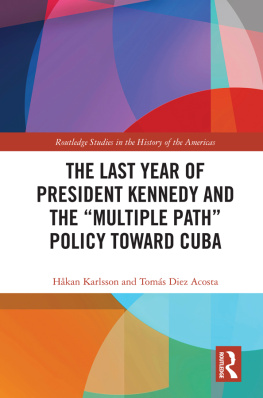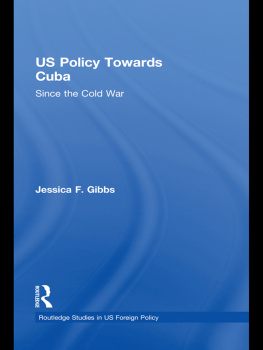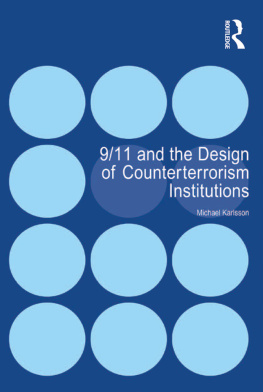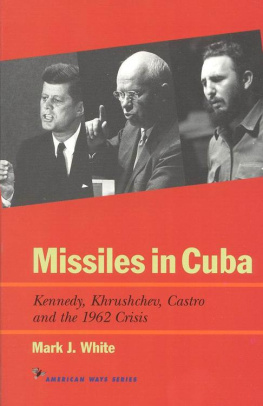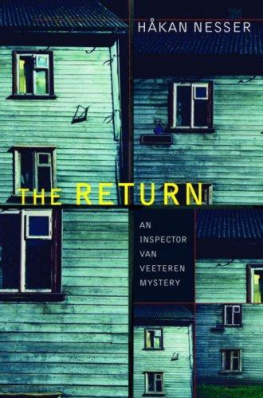The Cuban Government has put forward a proposal declaring that it is ready to hold discussions with all those who are prepared to work for the improvement of relations and with all countries including the United States. But their answer is: new aggressions against our country, new aggressive schemes and activities and the adoption of a series of steps to set up war bases in Central America to carry out aggressive activities against Cuba. They do not want to live together with us, but we are here and we shall remain here.
Fidel Castro, July 21, 1963.
The Last Year of President Kennedy and the Multiple Path Policy Toward Cuba
This book presents new aspects of the U.S. multiple path policy toward Cuba that was designed and adopted after the Missile Crisis (October 1962) until the assassination of President Kennedy on November 22, 1963, from a Cuban perspective. The policy was characterized by its contradictory profile, since simultaneously as aggressions were directed at Cuba, it also included the establishment of channels of communication with the Cuban government. The book also analyzes the CubanSoviet dispute during the same period. The Cuban experiences have still not been sufficiently discussed, and the aspects offered will enrich the knowledge of the U.S.Cuban relationship during the mentioned period.
Hkan Karlsson is Full Professor in Archaeology at the Department of Historical Studies, University of Gothenburg, Sweden.
Toms Diez Acosta is Professor and Researcher at the Instituto de Historia de Cuba.
Routledge Studies in the History of the Americas
Tuberculosis in the Americas, 18701945
Beneath the Anguish in Philadelphia and Buenos Aires
Vera Blinn Reber
Negotiating Freedom in the Circum-Caribbean
The Jamaican Maroons and Creek Nation Compared
Helen M. McKee
The Missile Crisis from a Cuban Perspective
Historical, Archaeological and Anthropological Reflections
Hkan Karlsson and Toms Diez Acosta
Science and Society in Latin America
Peripheral Modernities
Pablo Kreimer
Traces and Memories of Slavery in the Atlantic World
Edited by Lawrence Aje and Nicolas Gachon
Transnational Perspectives on the Conquest and Colonization of Latin America
Edited by Jenny Mander, David Midgley and Christine D. Beaule
The Global Perspective of Urban Labor in Mexico City, 19101929
El Mundo al Revs
Stephan Fender
The Last Year of President Kennedy and the Multiple Path Policy Toward Cuba
Hkan Karlsson and Toms Diez Acosta
For more information about this series, please visit: www.routledge.com/Routledge-Studies-in-the-History-of-the-Americas/book-series/RSHAM
The Last Year of President Kennedy and the Multiple Path Policy Toward Cuba
Hkan Karlsson and Toms Diez Acosta
First published 2020
by Routledge
52 Vanderbilt Avenue, New York, NY 10017
and by Routledge
2 Park Square, Milton Park, Abingdon, Oxon, OX14 4RN
Routledge is an imprint of the Taylor & Francis Group, an informa business
2020 Taylor & Francis
The right of Hkan Karlsson and Toms Diez Acosta to be identified as authors of this work has been asserted in accordance with sections 77 and 78 of the Copyright, Designs and Patents Act 1988.
All rights reserved. No part of this book may be reprinted or reproduced or utilised in any form or by any electronic, mechanical, or other means, now known or hereafter invented, including photocopying and recording, or in any information storage or retrieval system, without permission in writing from the publishers.
Trademark notice: Product or corporate names may be trademarks or registered trademarks, and are used only for identification and explanation without intent to infringe.
Library of Congress Cataloging-in-Publication Data
Names: Karlsson, Hakan, 1962 author. | Diez Acosta, Tomas, author.
Title: The last year of President Kennedy and the multiple path policy toward Cuba / Hakan Karlsson and Tomas Diez Acosta.
Description: New York, NY : Routledge Taylor & Francis, 2020. | Series: Routledge studies in the history of the Americas; vol. 11 | Includes bibliographical references and index.
Identifiers: LCCN 2019046899 (print) | LCCN 2019046900 (ebook) | ISBN 9780367368425 (hardback) | ISBN 9780429351709 (ebook) | ISBN 9781000768503 (adobe pdf) | ISBN 9781000768510 (mobi) | ISBN 9781000768527 (epub)
Subjects: LCSH: United StatesForeign relationsCuba. | CubaForeign relationsUnited States. | CubaForeign relationsSoviet Union. | Soviet UnionForeign relations Cuba. | Cuban Missile Crisis, 1962. | CubaForeign relations19591990. | United StatesForeign relations19451989. | Kennedy, John F. (John Fitzgerald), 19171963. | Castro, Fidel, 19262016.
Classification: LCC E183.8.C9 K37 2020 (print) | LCC E183.8.C9 (ebook) | DDC 327.7307291dc23
LC record available at https://lccn.loc.gov/2019046899
LC ebook record available at https://lccn.loc.gov/2019046900
ISBN: 978-0-367-36842-5 (hbk)
ISBN: 978-0-429-35170-9 (ebk)
Typeset in Sabon
by ApexCovantage, LLC
Contents
PART I
Kennedy and the Anti-Cuban Policy After the October Crisis
PART II
The Multiple Path Policy
PART III
The Cuban-Soviet Dispute and the Reinforcement of the Cuban Defense
PART IV
The Ambivalence of the Multiple Path Policy
The book The Last Year of President Kennedy and the Multiple Path Policy Toward Cubawhich we now present for the reader, is intended to provide detailed information on the policy of hostility and aggression by the U.S. toward Cuba after the end of the October Crisis in 1962, usually referred to as the Missile Crisis, until the assassination of President Kennedy on November 22, 1963. Based on U.S. as well as Cuban governmental sources, the book studies the anti-Cuban policy of the Kennedy administration during its last year, when Cuba had to face and defeat the dirty war imposed on the country as a result of the multiple path policya policy characterized by its ambivalence, since simultaneously to the implementation of the CIAs Integrated Covert Action Program informal contact channels were established with the Cuban revolutionary leadership. The Cuban documents also allow an analysis of the Cuban-Soviet disputewhich emerged during the negotiations of the aforementioned crisisand of the process of strengthening the Cuban defense system. These aspects cannot be neglected in any serious study of the period.
When analyzing the historical events that have taken place during the last 60 years in the bilateral relations of confrontation and conflict between the U.S. and Cuba, we must bear in mind that this is not a completed process, since it is still in progress today. U.S. imperialism and the enemies of the Cuban Revolution are betting on its destruction with the natural disappearance of the historical leadership that has led it triumphantly despite the enormous difficulties and limitations of all kinds that the Cuban people have had to experience to maintain the independence and the sovereignty of the nation.
The adversaries of the Revolution predict that the new generations of Cubansbesieged by a psychological war whose methods of ideological penetration are increasingly refined and sophisticatedwould not be in a position to accept all the kinds of limitations that the economic blockade imposes on their daily lives. One can only conclude that the same policy of hostility from the U.S., established in the beginning of the 1960s, is righteously qualified by many scholars in the world as a dinosaur of the Cold War era. However, one can also conclude that it is precisely this underestimation of the possibilities of resistance and confrontation of the Cuban people that has been the main miscalculation of all U.S. administrations since the triumph of the Cuban Revolution in 1959.


